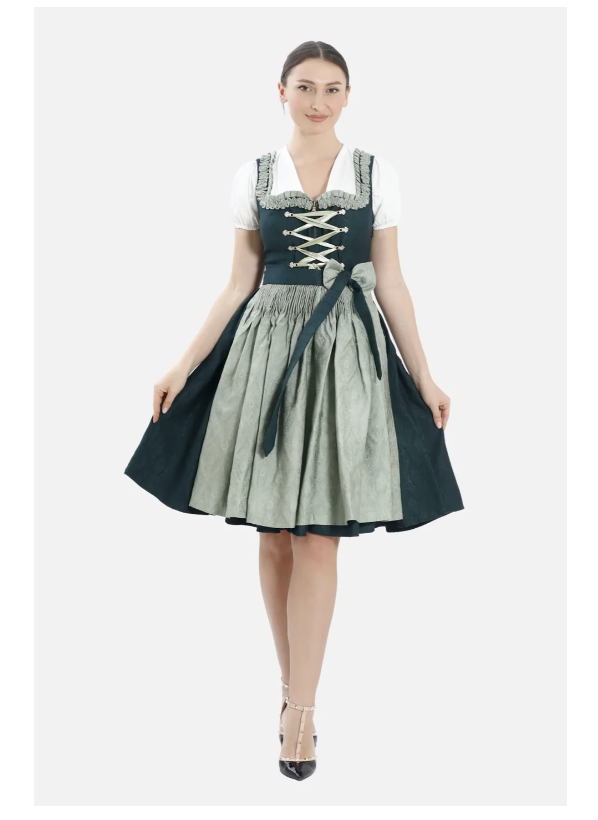Traditional garments can be modernized through various techniques, like incorporating new fabrics that perfectly complement the seasonal demand or adding embellishments that meet the updated trends. Centuries-old garments like the Japanese kimono, Indian saree, and German dirndl tell stories through fabric and form.
These pieces don’t fade; instead, they evolve and resurface. Lederhosen, originally crafted with durable leather and tanned shades, are now available in sustainable materials and minimalist classics. Designers have adapted seasonal elegance traditionally by bringing style and cultural richness into modern wardrobes with new materials and cuts.
Why Traditional Fashion Never Goes Out of Style?
Traditional clothing represents regional identity and historical eras. It features distinct fabrics, patterns, and craftsmanship that communities have passed down for generations. The authenticity of these pieces and their unique designs create a strong foundation for seasonal fashion. They allow designers to experiment with old textures and meaningful details, transforming cultural heritage into fresh, wearable statements.
Fashion houses bring tradition into the spotlight and prove that the past is not only relevant but also remarkably stylish. They are blending time-honored elements with modern silhouettes in regional clothing that connects individuals to their roots without compromising the updated styling needs. Moreover, the garments distinguish themselves through unparalleled variety, local artistry, and intricate embroidery. The Alpine dirndl exemplifies this with its structured bodice and symbolic hand-embossed detailing.
Traditional Wear in the Modern Spotlight
Today’s fashion industry borrows liberally from the past. It reinterprets folk styles into high-fashion statements. Runways in Berlin, Milan, and New York have featured embroidered bodices, structured skirts, and rustic fabrics. This directly nods to heritage attire like the dirndl.
Celebrities and influencers now adopt these traditional looks at festivals and even the red carpet, which fuels a global appreciation for culture-driven fashion and reinforces its place in seasonal collections.
Mexican actress Salma Hayek wore a traditional German dirndl to attend a television show, drawing inspiration from past classics.
Their visibility helps bridge the gap between old-world charm and contemporary fashion and turn them into a bold trend. Designers are more into mixing and matching elements to create a fresh look. For instance, incorporating styles like kimono sleeves or tweed patterns into modern wardrobes. The garments are continuously reinvented and modernized to ensure the values remain relevant to the current fashion scene.
Seasonal Adaptations: Blending Tradition with Updated Trends
Every day fashion now incorporates details rooted in heritage. It borrows, reinvents, and revives. Seasonal elegance comes alive when designers and wearers alike respect the regional values that shaped the latest trends.
You don’t need a full traditional Oktoberfest outfit to make a statement now. Pair a modern blouse with heritage-inspired embroidery, or simply opt for a lightweight cotton dirndl for your casual summer outing. This approach honors the past while balancing the contemporary appeal.
Fall & Winter: Structured Layers with a Heritage Edge
Designers lean into rich textures and heavier materials during the colder months. This often draws inspiration from Alpine traditions. Garments like men’s lederhosen and wool-trimmed dirndl jackets provide the blueprint for layered looks. These pieces provide warmth, structure, and a rustic edge that aligns with winter style.
Artisans may swap heavy embroidery for subtle patterns or replace traditional leather with eco-friendly suede to keep the essence intact while appealing to modern tastes. They also favor plaid and felted fabrics that mimic traditional garments and offer a sense of authenticity. Additionally, fall collections are dominated by dark earth tones like burgundy and brown from traditional autumn harvest festivals.
Spring & Summer: Light Fabrics, Folk-Inspired Details
Warmer seasons shift the focus toward breathability and movement. Designers revisit traditional dirndl aesthetics, such as light cotton, airy skirts, and pastel tones, to craft a fresh, elegant look suitable for spring and summer. You will often see floral embroidery inspired by traditional spring festivals, lace-trimmed hems, and puffed sleeves echoing folk fashion but executed in modern cuts like crop tops, midi skirts, or open-back dresses. These subtle details offer a modern twist on past fashion without losing their cultural roots. Moreover, the warmer months incorporate a soft color palette that comforts the visual eye.
Accessories: Subtle Statements Across Seasons
Accessories also follow seasonal adaptation. They offer an easy way to integrate classical elements into modern styling. In cooler months, updated takes on traditional boots and embossed leather belts reflect the rustic charm of traditional Bavarian attire. Meanwhile, warmer seasons introduce ribboned hairpieces or lightweight shawls with folk patterns. The result is a fluid blend where tradition guides the design, but the outcome feels current and fashion-forward.
Modern Design, Traditional Roots: The Perfect Balance
Designers are reimagining traditional silhouettes to create trendy pieces that capture the essence of historical fashion. Without abandoning the past, they reinterpret it. The fashion houses simply keep the cultural style relevant and wearable by adjusting fabrics, silhouettes, and colors to fit the season.
For instance, reinterpreting saree drapes in modern dresses and tops honors Indian roots with the perfect blend of a contemporary twist. Likewise, adapting the Scottish kilt into modern skirts with updated lengths and closures to appeal to current fashion sensibilities.
The clothing divas take the soul of traditional garments and mold them into modern expressions. They experiment with the design, like introducing length variations or more tailored fits to suit various occasions or seasonal demands. Outfits inspired by lederhosen and dirndl now appear in both casual and formal collections. They have been modified with sustainable formats and minimalist designs. The balance of innovation and heritage allows the wearer to connect with their ancestors’ fashion legacy without committing to a full traditional outfit.
Wrapping Up!
As the line between the old and the new continues to blur, traditional outfits like leather shorts and dirndls will keep influencing collections. They become narrative in modern aesthetics without sacrificing authenticity. Designers extract key elements like pleated skirts or hand-stitched embellishments and reimagine them with seasonal materials. They don’t replicate but actively reshape the cultural dresses to create collections that are wearable year-round and connect the past to the present.

